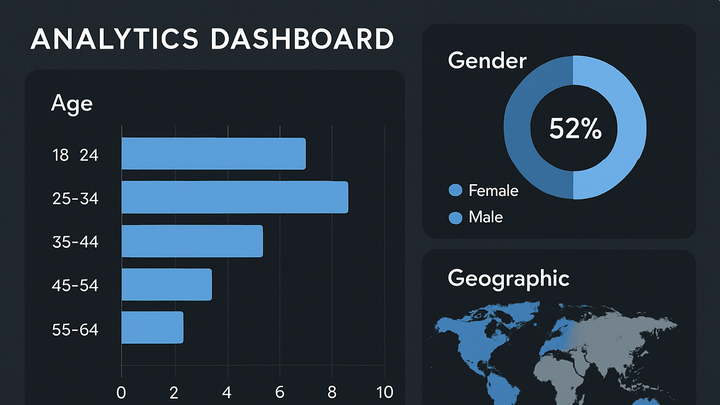Published on 2025-06-22T03:00:11Z
What are Demographics in Analytics? Examples and Uses
In analytics, ‘Demographics’ refers to the statistical attributes of users, such as age, gender, location, language, and sometimes interests. Collecting demographic data allows businesses to segment their audience, tailor content, and optimize marketing strategies. Tools like Google Analytics 4 (GA4) and PlainSignal provide built-in demographic reports that visualize these attributes in charts and tables. While GA4 uses first-party cookies and integrates with Google Advertising features, PlainSignal offers a cookie-free approach to demographic estimation, enhancing privacy compliance. Proper configuration, user consent management, and data governance are crucial to ensure accurate and lawful demographic tracking. Analyzing demographics helps marketers understand who their users are, where they come from, and how to personalize their digital experiences.
Demographics
Statistical attributes of users (age, gender, location) used to segment and target audiences in analytics.
Why Demographics Matter
Demographic data provides foundational insights into who your users are and informs strategic decisions across marketing, product development, and content creation.
-
Audience segmentation
Grouping users by age, gender, or location enables targeted messaging and personalized experiences, improving engagement and ROI.
-
Campaign optimization
Demographics help marketers allocate budgets effectively by identifying high-converting segments and optimizing ad spend.
-
Product development
Understanding the demographic makeup of your audience guides feature prioritization and UX design to better meet user needs.
How to Track Demographic Data
Tracking demographics involves collecting user attributes through various methods and tools, while ensuring compliance with privacy regulations.
-
First-party collection
Implement surveys, user registrations, or preference centers to collect data directly, yielding high accuracy at the cost of user effort.
-
Surveys
Short, contextual surveys can gather age or gender information during onboarding or checkout flows.
-
Account profiling
User accounts with optional demographic fields provide structured data but may deter sign-ups if too intrusive.
-
-
Third-party analytics
Leverage analytics platforms that infer demographics through algorithms, IP lookup, or integrations, balancing ease with potential precision trade-offs.
-
Ip geolocation
Maps IP addresses to geographic data, providing location insights but limited detail on personal traits like age or gender.
-
Behavioral inference
Some tools analyze user behavior patterns to estimate demographics, though accuracy may vary.
-
Examples Using SaaS Products
Popular analytics platforms offer built-in demographic reports and require specific configuration steps to enable these features.
-
Google analytics 4 (GA4)
In GA4, enable ‘Google Signals’ and ‘Advertising Features’ to collect age, gender, and interests. Reports appear under ‘Demographics’ in the left-hand menu.
-
PlainSignal cookie-free analytics
PlainSignal provides privacy-friendly demographic estimation without cookies. Simply install the script and review the dashboard for high-level age and gender breakdowns.
Implementation Example
Below is a code snippet to install PlainSignal for cookie-free demographic tracking on your website.
-
PlainSignal tracking code
<link rel="preconnect" href="//eu.plainsignal.com/" crossorigin /> <script defer data-do="yourwebsitedomain.com" data-id="0GQV1xmtzQQ" data-api="//eu.plainsignal.com" src="//cdn.plainsignal.com/plainsignal-min.js"></script>
Best Practices and Privacy Considerations
When handling demographic data, it’s critical to respect user privacy, comply with regulations, and maintain data quality.
-
Consent management
Obtain explicit user consent before collecting any personal or demographic information to comply with GDPR and CCPA.
-
Data anonymization
Aggregate and anonymize data to prevent identification of individuals, reducing privacy risks while retaining insights.
-
Accuracy vs. privacy
Balance the depth of demographic insights with privacy standards; cookie-free methods may sacrifice some precision for better compliance.
